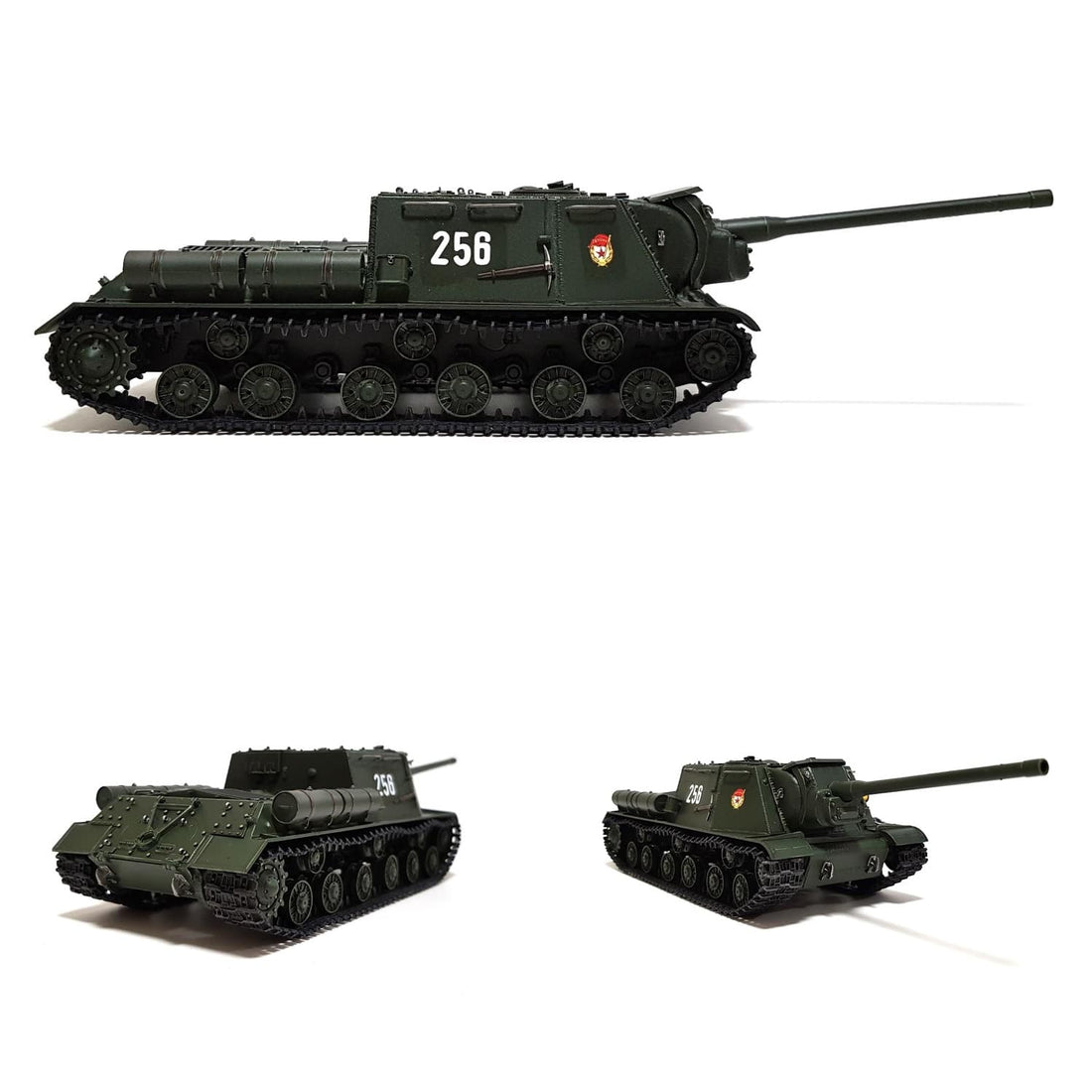
1:35 JSU-122 Tank Destroyer from DRAGON
Share
The ISU-122 was a Soviet assault gun used during World War II, mostly in the anti-tank role. A prototype of the ISU-122 heavy self-propelled gun was built at the Chelyabinsk Kirov Plant (Chelyabinskiy Kirovskiy Zavod (ChKZ), Chelyabinsk, Russia), in December 1943. The design shared the chassis of the ISU-152 self-propelled gun and differed only in armament, having an A-19S 122-mm gun as its main weapon instead of the ISU-152's ML-20S gun-howitzer. Towed versions of these guns used the same carriage: 52-L-504A, so installation of an A-19 instead of an ML-20 gun was not a difficult task. After completing development of the ISU-152, ChKZ engineers mounted the A-19 gun on the ISU-152 chassis to create "Object 242" - the first ISU-122 prototype. It was successfully tested, but not immediately launched into mass production.
At that time, all ISU hulls were being equipped with the ML-20S gun-howitzer, but the production of hulls increased quickly and there was a lack of ML-20S tubes in the beginning of 1944. State authorities ordered these uncompleted hulls armed with an A-19 gun (specifically with the A-19S variant, slightly modified for the self-propelled gun mount). A further advantage of rearming the ISU was increased direct fire range against heavy German tanks. For these reasons, the State Defense Committee adopted Object 242 for Red Army service as the ISU-122 on 12 March 1944. In April 1944, the first series ISU-122 left the ChKZ production lines.
The A-19S gun had a manual-piston breech, which reduced the rate of fire from 2.5 to 1.5 shots per minute. Soviet designers developed the D-25 by modernizing the A-19S's breech, creating a semi-automatic variant of the 122-mm gun. The D-25 gun was installed in IS-2 tanks as a priority, but in September 1944 became available for self-propelled guns. The prototype ISU vehicle, armed with a D-25S was designated "Object 249" and successfully passed plant and state testing. The fire rate was improved to 2 to 3 shots per minute and with two strong experienced loaders the rate of fire reached 4 shots per minute. Due to the muzzle brake reducing recoil forces, the D-25 had a smaller recoil buffer than the A-19. This improved the crew's work conditions and allowed for a smaller, lighter gun shield with the same armour thickness.
After testing, Object 249 was immediately launched in mass production as the ISU-122S self-propelled gun. However, the original ISU-122 remained in production (along with the ISU-152) due to a large stock of A-19 guns (the ML-20 and D-25 came directly from artillery factories). Mass production of the ISU-122 and ISU-122S ceased at the end of 1945. ChKZ produced 1,735 ISU-122 and 675 ISU-122S variants in total.
After World War II, many surviving ISU-122s were rebuilt as rocket launchers, very large calibre gun chassis or supply vehicles. The small number of ISU-122s that kept their original armament were modernized in 1958. This modernization was not as complete as that of the ISU-152. Most ISU-122s did not receive a new engine, only upgraded gun sights and radio sets. In the beginning of 1960, the ISU-122 was withdrawn from Soviet Army service (the ISU-152 served much longer). Some disarmed ISU-122s were transferred to civil organizations, to be used as emergency vehicles on Soviet railways or as tracked transport in Arctic areas of the Soviet Union.
At that time, all ISU hulls were being equipped with the ML-20S gun-howitzer, but the production of hulls increased quickly and there was a lack of ML-20S tubes in the beginning of 1944. State authorities ordered these uncompleted hulls armed with an A-19 gun (specifically with the A-19S variant, slightly modified for the self-propelled gun mount). A further advantage of rearming the ISU was increased direct fire range against heavy German tanks. For these reasons, the State Defense Committee adopted Object 242 for Red Army service as the ISU-122 on 12 March 1944. In April 1944, the first series ISU-122 left the ChKZ production lines.
The A-19S gun had a manual-piston breech, which reduced the rate of fire from 2.5 to 1.5 shots per minute. Soviet designers developed the D-25 by modernizing the A-19S's breech, creating a semi-automatic variant of the 122-mm gun. The D-25 gun was installed in IS-2 tanks as a priority, but in September 1944 became available for self-propelled guns. The prototype ISU vehicle, armed with a D-25S was designated "Object 249" and successfully passed plant and state testing. The fire rate was improved to 2 to 3 shots per minute and with two strong experienced loaders the rate of fire reached 4 shots per minute. Due to the muzzle brake reducing recoil forces, the D-25 had a smaller recoil buffer than the A-19. This improved the crew's work conditions and allowed for a smaller, lighter gun shield with the same armour thickness.
After testing, Object 249 was immediately launched in mass production as the ISU-122S self-propelled gun. However, the original ISU-122 remained in production (along with the ISU-152) due to a large stock of A-19 guns (the ML-20 and D-25 came directly from artillery factories). Mass production of the ISU-122 and ISU-122S ceased at the end of 1945. ChKZ produced 1,735 ISU-122 and 675 ISU-122S variants in total.
After World War II, many surviving ISU-122s were rebuilt as rocket launchers, very large calibre gun chassis or supply vehicles. The small number of ISU-122s that kept their original armament were modernized in 1958. This modernization was not as complete as that of the ISU-152. Most ISU-122s did not receive a new engine, only upgraded gun sights and radio sets. In the beginning of 1960, the ISU-122 was withdrawn from Soviet Army service (the ISU-152 served much longer). Some disarmed ISU-122s were transferred to civil organizations, to be used as emergency vehicles on Soviet railways or as tracked transport in Arctic areas of the Soviet Union.
